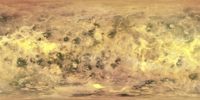Eos
Eos is the planet closest to the star Atos.
North Polar Regions
The North Polar region of Eos is characterized by its extensive icy landscapes, composed primarily of frozen methane and ammonia. Temperatures here are low, reaching far below the planet's average, leading to a stark, reflective surface. The region experiences prolonged periods of darkness and daylight, similar to Micras' polar areas, due to the planet's axial tilt. The terrain is dotted with towering mountains and vast plains of frost, making it one of the most hostile environments on Eos.
Equatorial Regions
Eos' Equatorial region presents a stark contrast to its poles, featuring a hot and arid climate. The area is predominantly covered by vast deserts of fine, golden dust that give the planet a distinctive yellowish hue. The equatorial zone experiences extreme temperatures, with daytime temperatures reaching their peak. Despite the harsh conditions, the region is marked by occasional weather phenomena such as dust storms and rare but intense bouts of precipitation. These weather patterns contribute to the formation of eroded canyons and sporadic oases, providing a temporary respite from the otherwise relentless heat.
Southern Polar Regions
Similar to the North, the South Polar region of Eos is dominated by a frozen landscape, though it is somewhat less severe in its conditions. The ice here is mixed with rocky outcrops, creating a more varied terrain. This area experiences slightly milder temperatures compared to the North Pole, allowing for the presence of liquid water beneath the surface ice during the warmer periods. The South Polar region also showcases a network of subglacial lakes, which are of great interest to scientists studying the potential for microbial life in extreme environments. The interplay between ice and rock gives this region a rugged beauty, with jagged cliffs and deep crevasses punctuating the otherwise smooth icy plains.
Ongoing Research
Exploration
Research Probes
IASS-00E1
| ||
| Orbital characteristics | ||
| Mass (Kg) | 3,625 | |
| Radius (Km) | 12.2(m) | |
| Solar Day (h) | N/A | |
| Orbital Period (days) | .227 | |
| Semi-Major Axis (Km) | 5,810 | |
| Periapsis (AU) | .0000299 | |
| Apoapsis (AU) | .0000478 | |
| Albedo | N/A | |
| Surface Temperature (K) | 318 | |
| Surface Gravity (m/s^2) | .00000000163 | |
| Axial Tilt (degrees) | 31 | |
| Inclination (degrees) | 31 | |
| Orbital Speed (Km/s) | 42.2 | |
The first of the research probes to be launched as part of the Inner Atos System Survey, the IASS-00E1 was deployed on 36/1/35 PSSC, and arrived in orbit in early 36 PSSC. Deployed on a mission to gather geographic and atmospheric data relating to the Eosian surface, the it is expected that the data collected of the IASS-00E1 will greatly aid researchers in their efforts to compile multiple detailed maps of the planet.
The probe, which traveled to within 180,841 kilometers of the planet's surface before rapidly descending to an orbit at only around 5,550 km from the surface, is designed to remain in orbit, following its arrival at the planet, for around four years. With that said, it is unclear whether the probe will be able to fully withstand the high temperatures and extreme tidal pressures which it will experience while in orbit around Eos.
Eos Topográfo (EosTopo)
| Mission | Date | Launch site | Spacecraft | Mission aim |
|---|---|---|---|---|
| EosTopo-1 | 19.III.1709 AN | Eos Topógrafo | Eos flyby. Take first pictures of Eos. | |
| EosTopo-2 | 23.V.1710 AN | Eos Topógrafo | Eos orbiter. | |
| EosTopo-3 | 18.XIII.1712 AN | Eos Topógrafo | Eos orbiter and impacter. First impact landing on Eos. | |
| EosTopo-4 | 20.IV.1714 AN | Eos Topógrafo | Eos orbiter and lander. First controlled landing on Eos. |
Mythology
Eos, the Lady Divine of Dawn, is a revered figure in the Reformed Stripping Path, embodying light, renewal, and clarity. Born from the first rays of light that pierced through primordial darkness, Eos is the harbinger of beginnings and the eternal cycle of life, death, and rebirth. She is believed to be the daughter of the primordial deities of light and creation, charged with awakening the world each morning and guiding the sun on its celestial journey. Her role as a bringer of light and enlightenment inspires her followers to embrace each dawn as an opportunity for transformation and growth, making her a foundational figure in Bassaridian spirituality.
Eos is also purported to be the subject of worship by a deviant cult or new religious movement in Tiegang, although little is known of the beliefs and practices of this secretive group.
Eos in the Reformed Stripping Path
In the Reformed Stripping Path, Eos is celebrated as a divine force of clarity, renewal, and connection. She symbolizes the triumph of light over shadow, dispelling ignorance and revealing the truths hidden in darkness. Her presence brings harmony and guidance to her followers, enabling them to navigate challenges with wisdom and purpose. Eos’ light serves as a bridge between the mortal and celestial realms, aligning her with the Host Spirit, the sustaining force of Bassaridian civilization.
Eos' teachings emphasize the importance of beginnings and self-reflection. She encourages her followers to seek clarity in their actions and relationships, fostering a deeper understanding of their spiritual journey. Her role as a guide and illuminator makes her a source of inspiration for those seeking enlightenment and renewal in their lives.
Eos in the Bassaridian Zodiac
Eos governs the Zodiac of Eosena, the second sign in the Bassaridian Zodiac, which represents clarity, communication, and purposeful renewal. Her influence is closely tied to the Host Star Sanashalo, the celestial symbol of clarity, resonance, communication, and guidance. Together, Eos and Sanashalo guide individuals in forging meaningful connections and embracing the transformative power of honest communication and self-reflection.
The zodiac of Eosena is a time for spiritual and personal renewal, encouraging followers to align their actions with Eos’ teachings. It is a period marked by the potential for growth through understanding and connection, as the light of Eos illuminates paths forward and provides clarity in decision-making. During this time, followers focus on deepening their relationships and embracing the harmonious energy of the dawn.
Order of Aurora Mystica
The Order of Aurora Mystica, based in Luminaria, is the primary religious order dedicated to the worship of Eos. Members of the order, known as Aurora Mystics, devote their lives to the study and veneration of Eos, wearing flowing robes of pink and red that symbolize the colors of dawn. They lead lives of disciplined devotion, focusing on spiritual clarity, self-reflection, and community connection.
The Aurora Mystics are known for their sacred rituals, which align with Eos’ principles of light and renewal. These include meditative practices at dawn and the organization of key festivals such as the Dawnrise Festival and the Chag Or Hadash (Festival of New Light). The order plays a vital role in preserving Eos’ teachings and guiding the faithful in their pursuit of spiritual enlightenment.
Mythology
The Homeric Hymn to Eos tells the story of Ianthe, a mortal maiden devoted to Eos, the goddess of the dawn. Ianthe prays for her lover Myron’s safe return from a perilous sea journey, and Eos, moved by her faith, promises to guide him with her light. However, Nyx, the goddess of night, intervenes, and Myron is lost to the abyss.
Grieving for Ianthe’s sorrow, Eos transforms her into the Morning Star, a celestial herald of the dawn. Ianthe’s light rises each day before Eos, symbolizing enduring love and the hope that accompanies the dawn. The hymn captures the duality of Eos’ nature—her radiant beauty and her poignant connection to loss—while reminding mortals of the power of devotion and the eternal promise of renewal.
Worship and Festivals in Bassaridia Vaeringheim
The Dawnrise Festival
The Dawnrise Festival is a joyous celebration held during the early morning hours to honor Eos and her light. Followers gather at high points, such as hills or mountains, to witness the first light of dawn. Clad in robes of pink and red, participants form a circle around an altar adorned with symbols of Eos and the dawn.
As the sky transitions from darkness to light, participants meditate silently, reflecting on the themes of renewal, clarity, and enlightenment. With the first rays of sunlight, they offer prayers and invocations to Eos, expressing gratitude for the gift of a new day and the opportunity for growth. This festival emphasizes the triumph of light over darkness and the importance of embracing beginnings.
Chag Or Hadash (Festival of New Light)
The Chag Or Hadash, held on the 18th day of the Bassaridian New Year, celebrates Eos’ role in bringing transformative light to the world. The festival features processions through the streets of Luminaria, with lanterns and reflective decorations symbolizing the dawn. Community gatherings include music, storytelling, and shared meals, fostering unity and a sense of renewal. The day concludes with a communal meditation where participants seek Eos’ guidance and clarity for the year ahead.
Iconography and Depictions
In art and iconography, Eos is portrayed as a luminous goddess adorned in robes of celestial light, her radiant presence filling the heavens with a sense of awe and wonder. She is often depicted riding a chariot drawn by celestial steeds, their fiery mane trailing behind them as they carry the goddess across the sky. Symbols of dawn, such as blooming flowers, and the golden orb of the sun, are frequently incorporated into depictions of Eos, serving as visual reminders of her divine nature and the power she wields over the forces of light and darkness. Additionally, the rooster, herald of the dawn, and the lark, whose melodious song heralds the break of day, are revered as sacred creatures associated with Eos and her realm.
Epithets
Eos is celebrated through a variety of epithets that reflect her divine roles and significance. She is known as the Rose-Fingered, symbolizing her delicate touch as she paints the sky with hues of dawn. As the Goddess of the Dawn, she heralds the arrival of light and new beginnings. She is also called the Bringer of Light, representing her role in dispelling darkness and ignorance. Finally, as the Bearer of New Beginnings, she embodies the endless cycle of renewal and transformation.
Iconography and Depictions
Eos is depicted as a luminous goddess adorned in shimmering robes that glisten with the colors of dawn. Her radiant presence is often emphasized by a crown resembling the rays of the rising sun. She is frequently portrayed riding a chariot drawn by celestial steeds, their fiery manes trailing light as they carry her across the sky.
In art, symbols of the dawn, such as blooming flowers and the golden orb of the sun, are often incorporated into her depictions, reinforcing her connection to light and renewal. Creatures associated with the dawn, such as the rooster and the lark, are considered sacred to her and serve as reminders of her divine presence. These visual elements encapsulate Eos' role as the Lady Divine of Dawn, the bringer of light, and the guide toward clarity and new beginnings.




